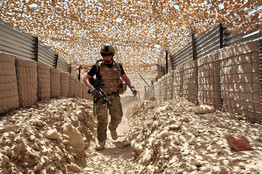
In just a few short months, American troops will be replacing the embedded British soldiers in most of Helmand province. These British troops have spent the past several years attempting to bring stability to one of Afghanistan’s most violent and unstable regions. For instance, one-third of the 335 British soldiers killed in the country since 2001 have met their end in the Helmand city of Sangin. As this excellent report by Michael M. Phillips of the Wall Street Journal details, for all their sacrifice, the British have a mixed record of success to hand over to the American forces replacing them:
Over the coming months, U.K. forces will leave Sangin and turn it over to the U.S. to finish the job.
Neither British nor U.S. officers describe it this way aloud, but it’s hard to avoid the conclusion that U.S. Marines are being sent in to complete what the undermanned British couldn’t, in a province once known as Helmandshire for the U.K.’s dominance here…..
The British contribute the second-largest force to the international coalition. Still, the U.K. has just 9,500 troops in Afghanistan, most of them in Helmand, while the U.S. has 10 times as many in the country, including 20,000 Marines in Helmand.
The British “have decided, given limited resources, to focus on the central part of the province” and leave the hot spots of northern Helmand to the U.S., says Col. Paul Kennedy, commander of U.S. Marine forces in the area.
The bloodiest battlefield they are leaving is Sangin, a crossroads for insurgent fighters, drugs and money that has assumed mythic status in Britain. The U.K. has lost at least 106 men there since coming to town in 2006, with 36 of them falling this year, according to the Ministry of Defense.
“On the lowest level, it’s hard to fault the commitment and bravery of the lads,” says Maj. Alderson, the Royal Marine officer. “This isn’t two weeks in the French trenches and going to the rear. It’s six months of constant patrols. This is some of the toughest fighting I’ve ever seen.”
The British say they have improved both security and governance, at least in the town’s commercial center. Last year, the British counted 399 shops open in the bazaar; now there are 1,400, selling everything from cars and motorcycles to groceries and household goods under solar-powered lights provided by the international coalition.
“We’ve invested a lot of blood and treasure in Sangin. Has it been worth it?” asks Royal Marine Maj. Paul Lynch, commander of Delta Co., 40 Commando Group. “We’ve made progress in governance and socioeconomic development for the people of Sangin. That’s why we came.”
Brave lads, indeed. To say the Americans are inheriting a difficult task is one big understatement:
The true test will come over the next two months, when the last Royal Marines leave Sangin to the U.S. Marines. Right now, the Americans just have to fight; they don’t have to manage relations with the local Afghan government, navigate tribal politics or promote economic growth.
Once the Royal Marines are gone, those jobs will fall to the U.S. Marines.
(Photo Source: WSJ)